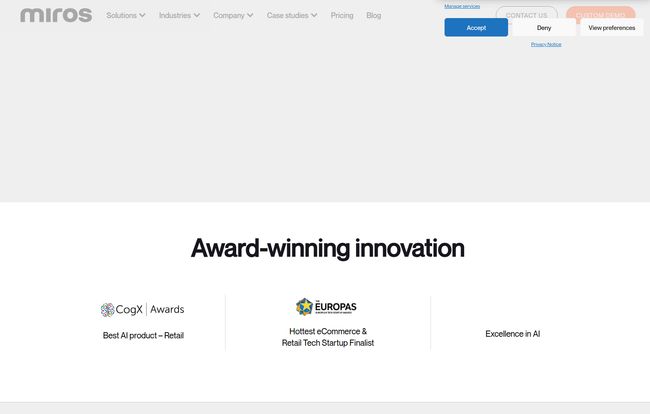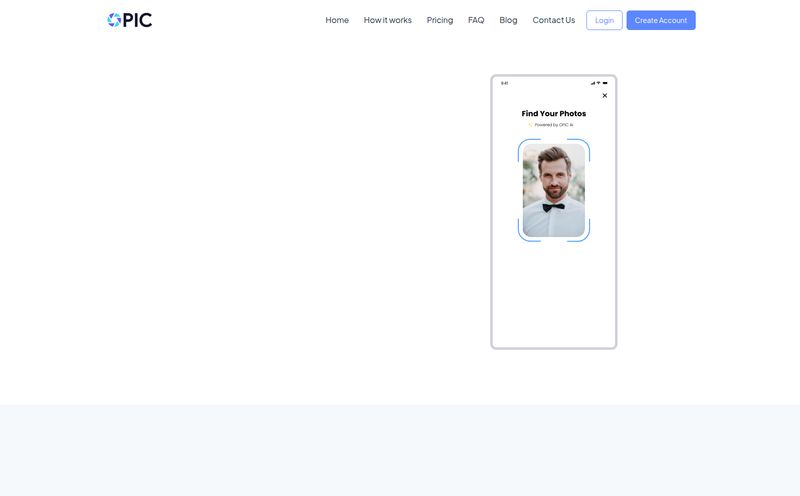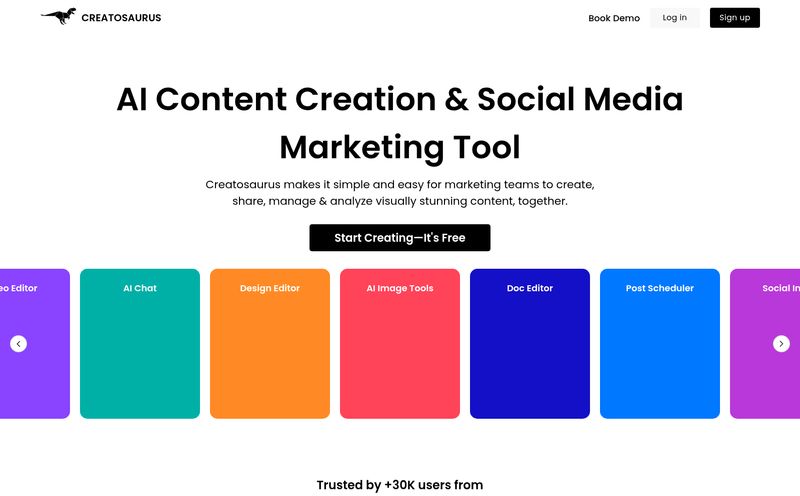As an SEO guy who lives and breathes user experience, one of my biggest pet peeves is clunky e-commerce search. You know the drill. A customer lands on a beautiful site, full of potential purchases, and heads to the search bar. They type "summer floral midi dress." The site returns zero results. They try again: "flowery dress for warm weather." Nothing. Frustrated, they try one last time—"dress"—and are assaulted with 5,000 products, most of which are completely irrelevant. They bounce. And you lose a sale.
It’s a tale as old as online shopping. We've spent decades teaching humans to speak 'computer'—to guess the exact keyword sequence a developer hardcoded into the backend. But what if the computer could learn to understand us? What if it could figure out what we want without us even having to type a word? That’s not a sci-fi pitch. It's the promise of a tool I've been looking at recently called Miros.
It sounds a bit like magic. Or maybe a little creepy. But in the world of conversion rate optimization, it’s downright fascinating.
What Exactly is Miros AI? (And Why Should You Care?)
At its core, Miros is an AI-powered platform for e-commerce sites that champions something they call “Wordless Search.” The idea is simple but powerful: instead of relying on a user typing in keywords, the AI observes their browsing behavior. What they click on, what they hover over, the style of the products that catch their eye—it’s all data. The AI then uses this behavior to instantly surface other products the shopper is likely thinking about. It's less of a search engine and more of a digital shopping assistant that has an uncanny knack for reading the room.

Visit Miros
Think about walking into a physical boutique. A good salesperson doesn't just stand there and wait for you to ask for "item number 54-B." They watch you. They see you're gravitating towards the linen shirts, that you keep touching the brightly colored scarves. They might then say, "If you like that, you have to see this new linen blazer that just came in." That’s the experience Miros is trying to replicate online. It’s a shift from explicit, often-frustrating search to implicit, intuitive discovery. And for an industry obsessed with reducing friction, that’s a pretty big deal.
How Does This AI Sorcery Actually Work?
Okay, “mind reading” is a great marketing hook, but we’re professionals here. So how does it actually work? It’s not pulling thoughts out of thin air. It’s a pretty logical, albeit sophisticated, five-step process.
- Data Extraction: First, Miros essentially hoovers up your entire product catalog. It needs to know what you’re selling, from images to descriptions and SKUs. Standard stuff.
- Data Enrichment: This is where it gets clever. The AI analyzes everything and starts adding its own descriptive tags and attributes to your products, far beyond what you'd ever do manually. It learns visual cues, styles, textures, and contexts. It's like a tireless, hyper-observant merchandising intern that never sleeps.
- Model Training: Now, the AI becomes a student of human behavior. It watches how real shoppers interact with your site. It starts connecting the dots: people who look at these three products often end up buying that one. It learns the subtle patterns of intent.
- Real-time Adaptation: This isn't a one-and-done setup. The AI is constantly learning and adjusting in real time. If a shopper starts by looking at black boots but then pivots to brown loafers, Miros pivots with them, refining its suggestions on the fly.
- Shop As You Want: The result for the shopper is an experience that just... flows. Products that match their vibe just appear. It feels effortless, almost like the site is finishing their thoughts for them.
So, it’s not sorcery. It's just very, very smart pattern recognition. Which, to be fair, can feel like the same thing when it works well.
The Core Miros Features That Drive Conversions
Miros isn't just a one-trick pony. The Wordless Search is the headliner, but it’s part of a bigger suite of tools designed to get the right products in front of the right people.
The Star Player: Wordless Search
This is the main event. By letting users discover products visually and behaviorally, you slash the frustration of failed keyword searches. It’s particularly powerful for industries like fashion, beauty, and home decor, where aesthetics and feel are more important than technical specs. You can't always put a vibe into words, but you know it when you see it.
Beyond Wordless: The Discovery Bar
I know, I know. I just spent ages talking about a “wordless” future, and now I’m mentioning a search bar. But stick with me. The Discovery Bar isn't your grandpa's search box. It uses Natural Language Understanding (NLU), meaning customers can type in conversational phrases like “jeans that aren’t skinny but still look modern” instead of “straight leg denim.” It’s for the power users who do know what they want to ask for, and it gives them a much smarter person to ask. Think of it less as a search bar and more as a conversation starter.
Don't Forget Recommended Items
Almost every e-com platform has a “You might also like” widget. Most of them are pretty dumb, based on simple rules like “people who bought X also bought Y.” Miros powers its recommendations with the same deep behavioral AI. The suggestions are more personalized and context-aware, leading to higher average order values and a much better discovery experience.
For the Tech-Savvy: API Access
For larger retailers or those with custom-built platforms, Miros offers API access to its Discovery Bar and Recommended Items features. This gives your dev team the freedom to integrate the tech in a completely bespoke way, which is a must-have for enterprises.
The Real-World Impact: Does Miros Actually Boost Sales?
This all sounds great on paper, but does it move the needle? Evidence suggests it does. By improving product discovery, you naturally improve the entire shopping experience. A happy, non-frustrated shopper is far more likely to convert. I’ve seen this principle play out time and time again in my own CRO projects.
And you don't have to take my word for it. Miros is trusted by some seriously big names in retail, like Jomashop, Momox, Perricone MD, and—perhaps most notably—fashion giant REVOLVE.
"Miros provided a different search approach to our customers who had a difficult time finding the right among thousands of products we offer on our website."
- Grace Hong, REVOLVE
That quote says it all. When you have a massive catalog, discovery is your biggest challenge. A tool that solves that is worth its weight in gold. It's the difference between a warehouse full of products and a curated showroom.
Let's Get Real: The Potential Downsides
No tool is perfect, and I'd be doing you a disservice if I painted this as a flawless silver bullet. There are a few things to keep in mind.
- The JavaScript Thing. Yes, you have to integrate a snippet of JavaScript code into your site. But honestly, if you're serious about e-commerce in 2024, you're already juggling snippets from Google Analytics, your email provider, a pixel or two... this is just one more. Plus, they offer implementation support.
- The AI Isn't Psychic. The AI is incredibly smart, but it’s still a machine working on probabilities. It can get things wrong, especially when it's first learning from your site's traffic. You have to manage your expectations. It's about making things better, not achieving 100% prophetic accuracy.
- Your Data Needs to Be Decent. The classic “garbage in, garbage out” principle applies here. Miros works best with a well-organized product catalog with good images and descriptions. For some stores, this might mean a little data housekeeping is in order before you can get started. A bit of a pain, maybe, but probably something you should do anyway.
So, What's the Price Tag on Mind Reading?
This is the million-dollar question, isn't it? As is common with enterprise-level SaaS solutions, Miros doesn't splash its pricing all over the homepage. You won't find a neat little three-tiered pricing table with a “Buy Now” button. This is a "let's talk" kind of service. You'll need to request a demo to get a custom quote based on your store's size, traffic, and needs.
While I can't give you a dollar amount, I can break down the features that are typically bundled into their plans:
| Feature/Service | Description |
|---|---|
| Wordless Search | The core AI-powered discovery without typing. |
| Recommended Items | Personalized product suggestions based on behavior. |
| Discovery Bar | Advanced search with natural language understanding. |
| API Access | For seamless, custom integrations on your platform. |
| Design & Implementation | Support for product catalog sync and getting started. |
The need to book a demo tells me their target customer isn't the dropshipper just starting out on Shopify. They're aiming for established stores that understand the value of investing in conversion optimization.
Who Is This Really For?
Based on their own case studies and the nature of the tech, Miros seems like a perfect fit for a few specific types of businesses:
- Fashion and Apparel Stores: Where style and visual appeal are everything.
- Home Decor & Furniture Retailers: Helping customers find pieces that match an aesthetic they can't easily describe.
- Beauty and Cosmetics Brands: Guiding users to the right shade or product based on subtle preferences.
More broadly, it's for any mid-to-large-sized e-commerce store with a substantial product catalog and enough traffic for the AI to learn effectively. If you have 20 products, you don't need an advanced discovery tool. If you have 20,000, you absolutely do.
Final Thoughts: A Glimpse of the Future?
After digging into Miros, I'm genuinely excited by the concept. For years, we've been trying to optimize a broken system—the keyword search bar. Miros and tools like it are proposing we move past it. The focus is shifting from search to discovery, and from keywords to intent.
It’s not just a cool piece of tech; it’s a fundamental change in the philosophy of online shopping. Is it the end of the search bar as we know it? Maybe not for everyone, not just yet. But it’s a powerful, compelling glimpse into a future where shopping online feels less like searching a database and more like a conversation. And that's a future that's bound to convert.
Frequently Asked Questions
What is Miros in simple terms?
Miros is an AI tool for online stores that helps shoppers find products they'll love without having to type in a search bar. It watches their browsing behavior to predict what they're looking for and shows them relevant items automatically.
Does Miros completely replace my existing search bar?
It can. The “Wordless Search” feature offers a different path to discovery. However, they also offer a “Discovery Bar” which is a super-smart, conversational search bar that can enhance or replace your existing one. You have options depending on your strategy.
Is Miros difficult to install on my website?
It requires adding a piece of JavaScript code to your site, which is standard for most third-party tools. Miros provides implementation support to help with the setup and synchronization of your product catalog.
What kind of online stores benefit the most from Miros?
Stores with large, visually-driven catalogs see the biggest benefit. This includes industries like fashion, home decor, and beauty. It's best for established stores with a steady stream of traffic that the AI can learn from.
Is the Miros AI always 100% correct?
No AI is perfect. While it's designed to be highly accurate, its primary goal is to improve the discovery experience and lift conversions, not to be a flawless psychic. It learns and gets better over time, but like any machine learning model, it works on probabilities.
How can I find out how much Miros costs?
Miros uses a custom pricing model. To get a quote for your business, you need to visit their website and schedule a demo with their team. They will assess your needs and provide a tailored plan.



